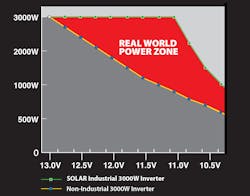Guest Blog: Power inverters: How much power is actually delivered?
In this blog, we are going to take a look at power inverters – specifically, do different power inverters deliver AC power differently, and if so, how do they differ? The answer is yes on numerous fronts, but today we are going to zoom in on one specific aspect of power delivery, which is how much power is actually delivered.
There’s a dirty little secret that many power inverter brands/manufacturers don’t really want you to know when it comes to the output ratings of their product. Many power inverters are rated for their output based on an impossible to achieve input voltage, such 13VDC. Unless your DC power source is being charged, it will never be at 13V State of Charge (SoC). A fully charged 12VDC power source will have an effective open-circuit voltage (after any surface charge has been removed) of 12.8VDC at best.
In the real world, where your DC power source is not connected to charging current and you are powering devices from your power inverter, it will continuously discharge from a full state of charge (~12.8VDC) to a discharged state of charge (11.5VDC, or 10 percent SoC). This is where work gets done – the accumulated power of the DC power source is transferred to the devices being powered during the working cycle of the system. But, what never happens is the delivery of power from a DC power source at 13.0VDC. Literally. Not. Ever.
So, an output rating based on an input voltage of 13.0VDC (or higher) is a rating that will never be achieved. And, what we have seen in these cases is that the output of such products declines rapidly as the 12V power source discharges. For instance, at 12.4VDC (~75 percent SoC), these products typically deliver only 60 percent of their rated output and fall off a cliff from there. This could mean that a power inverter rated at 2000W is actually delivering 750W when in use. We refer to this as 'The Real World Power Gap' resulting from underperformance due to false expectations based on unrealistic input ratings.
This is not the case with SOLAR Industrial Grade Power Inverters. Our power inverter products are designed to deliver the rated output until the DC power source discharges to 11VDC. That means, as the DC power supply driving the inverter discharges from full charge (~12.8V) to a discharged state (~11.0V), we keep powering your applications, allowing you to get the power you need, longer and better than most competitive models. That’s what we call 'The Real World Power Advantage' and it’s what you get from every SOLAR Industrial Grade Power Inverter.
Information provided by Clore Automotive
About the Author

Jim O' Hara
Clore Automotive
Jim O'Hara has over 15 years experience in the Tool and Equipment industry, including 10+ years at Clore Automotive. At Clore, he heads up the marketing team and is directly involved in the development of new products and enhancements of existing products.
